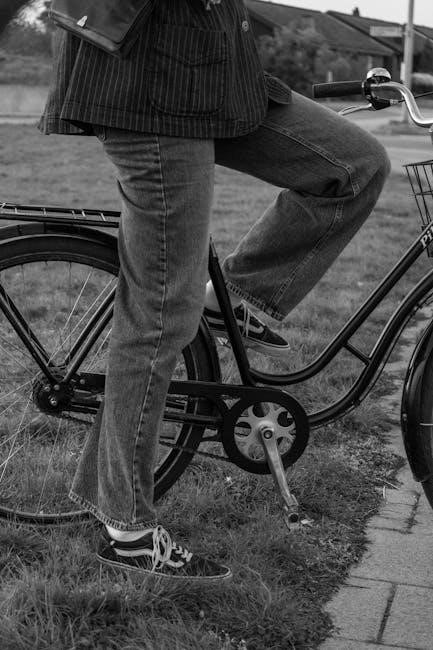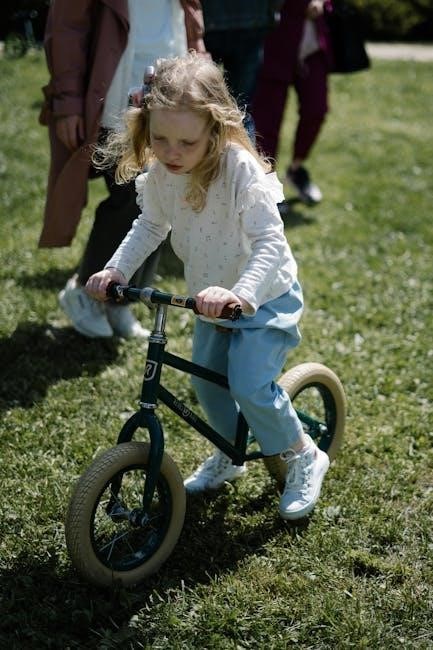Welcome to our comprehensive guide on bike shoe sizing! Proper sizing is crucial for both performance and comfort, ensuring optimal power transfer and reducing discomfort or pain during rides. With varying fit standards across brands, finding the right size can be challenging. This guide will help you navigate measurements, size conversions, and fit considerations to make informed decisions.

Importance of Proper Sizing for Performance and Comfort
Proper sizing in cycling shoes is essential for both performance and comfort. Ill-fitting shoes can lead to discomfort, pain, and even performance issues during rides. A snug fit ensures efficient power transfer, prevents foot movement, and reduces the risk of blisters or hotspots. Conversely, shoes that are too tight can restrict circulation and cause numbness, while overly loose shoes may lead to instability. Many cyclists experience foot swelling during long rides, making it crucial to account for this when choosing a size. Additionally, proper sizing supports arch and heel stability, which are vital for maintaining control and reducing fatigue. With brands offering varying fits and widths, finding the right size is key to maximizing comfort and performance. Material flexibility also plays a role in achieving the ideal fit.
How to Measure Your Foot for Cycling Shoes
To measure your foot, trace it on paper, noting the longest length from heel to toe and the widest width. Use this to compare with size charts.

Step-by-Step Guide to Accurate Foot Measurement
Accurate foot measurement is essential for selecting the right cycling shoes. Start by tracing your foot on paper, ensuring the pen is held perpendicular. Measure the length from the back of the heel to the tip of the longest toe. Next, determine the width by measuring around the widest part of the foot. Compare these measurements to a size chart, adding 5mm to the length for comfort. For brands offering width options, ensure the width matches your foot. This method helps in choosing the ideal size, balancing snugness and comfort for optimal performance during rides. Proper fit is key to avoiding discomfort and enhancing cycling efficiency.
Using a Size Chart for Initial Size Estimation
A size chart is a valuable tool for estimating your cycling shoe size. Start by measuring your foot length and width, then compare these to the chart provided by the manufacturer. Keep in mind that sizing varies between brands, so always refer to the specific brand’s chart; For example, Shimano and Giro may have slightly different sizing standards. If your measurement falls between sizes, consider sizing up to accommodate foot swelling during rides. Some brands offer wide options, which are ideal for those with wider feet. Using a size chart ensures a more accurate fit, but always try shoes on if possible, as online charts may not account for individual foot shapes or preferences.

Understanding Cycling Shoe Sizing Systems
Cycling shoe sizing systems vary by brand, often using European standards as a reference. Understanding these systems helps in selecting the correct size for optimal performance.
Differences Between European and US Sizing
European and US sizing systems differ significantly in cycling shoes; European sizes are measured in centimeters, typically ranging from 35 to 50, while US sizes use numerical increments. For example, a European size 43 often corresponds to a US size 9. This discrepancy stems from different measurement standards and foot shape averages. European sizing tends to be more precise, focusing on length in centimeters, whereas US sizing is less standardized, varying between brands. This can lead to confusion when converting sizes. Always refer to the manufacturer’s conversion chart to ensure accuracy, as direct size-to-size comparisons may not be reliable.
How to Convert Your Shoe Size Across Brands
Converting shoe sizes across brands can be tricky due to varying fit standards. Start by measuring your foot length and width accurately. Use the brand’s size chart to compare your measurements. Many brands provide conversion charts between US, European, and UK sizes. For example, a US size 9 often aligns with a European size 43. Some brands also offer wide or narrow fits, which may affect sizing. If unsure, consider trying shoes on or using customer reviews for fit insights. Remember, sizing can vary even within the same brand, so always double-check the specific model’s sizing guide for the best fit.

Factors Influencing Bike Shoe Fit
Foot width, arch support, and material flexibility significantly impact bike shoe fit. Proper support enhances comfort and performance, while material flexibility affects how the shoe molds to your foot.

Foot Width and Arch Support Considerations
Foot width and arch support are critical for a comfortable and efficient ride. Cyclists with wider feet may need to opt for shoes offering a high-volume or wide fit option. Arch support varies among brands, with some shoes featuring stiffer arches for better power transfer. Proper arch support prevents foot fatigue and discomfort during long rides. Additionally, material flexibility plays a role; stiffer materials provide more support but may be less forgiving for those with flatter arches. Ensuring the shoe matches your foot’s natural shape and support needs is essential for optimal performance and comfort.
Material Flexibility and Its Impact on Fit
Material flexibility plays a significant role in the fit and comfort of cycling shoes. Stiffer materials, often used in high-performance shoes, provide excellent power transfer but may feel less forgiving for riders with flatter arches or wider feet. More flexible materials, such as elastic uppers, allow for a snug yet adaptable fit, accommodating foot swelling during rides. Brands like Shimano offer shoes with elastic designs to stretch around wider feet while maintaining support. Conversely, brands like Bont cater to varying foot shapes with heat-moldable insoles for a customized fit. When choosing cycling shoes, consider your riding style and foot type to select materials that balance performance and comfort, ensuring optimal fit and support throughout your ride.

How to Choose the Right Size
Selecting the right cycling shoe size involves balancing snugness and comfort. Measure your foot length, consult brand-specific charts, and consider factors like foot swelling and width to ensure the best fit for optimal performance and comfort during rides.
When to Size Up or Down
Deciding whether to size up or down depends on your foot measurements and personal comfort preferences. If your foot length falls between two sizes, consider sizing up to accommodate foot swelling during rides. This is especially important for long rides, as feet tend to expand. However, if you prefer a snug fit for optimal power transfer, sizing down might be appropriate. Always refer to the brand’s size chart, as sizing can vary between manufacturers. Trying shoes on in the afternoon is recommended, as feet tend to swell throughout the day. Ensure there’s enough room for toe movement but avoid excessive space, which can lead to discomfort or reduced performance.
Considering Foot Swelling During Rides
Foot swelling during rides is a common phenomenon, especially on long or intense rides, due to increased blood flow and fluid retention. This can cause shoes to feel tight, leading to discomfort or even pain. To accommodate this, it’s advisable to leave a little extra space in the toe box—about 1-2 centimeters. This ensures toes can wiggle freely without pressure. Additionally, consider the time of day when trying on shoes; feet are typically at their largest in the afternoon. Brands often design shoes with adjustable features, like BOA dials, to allow for minor size adjustments. Proper fit is crucial for both comfort and performance, so don’t hesitate to test shoes under riding conditions if possible.
Testing the Fit of Your Cycling Shoes
Key Areas to Check for Comfort and Support
When testing the fit of your cycling shoes, ensure a snug but comfortable feel. Check the length—your toes should not touch the end but have a little room to move. The width should feel secure without pressure, and the heel should stay in place without lifting during pedaling. Arch support should feel firm but not overly rigid. Test the closure system, ensuring it’s adjustable and doesn’t cause pressure points. Finally, assess breathability and material flexibility, as these contribute to overall comfort during rides. These checks ensure your shoes provide optimal performance and reduce the risk of discomfort.
When testing the fit of your cycling shoes, focus on several key areas to ensure comfort and support. First, check the heel fit—it should stay secure without lifting during pedaling. The toe box should provide enough room for toe movement but avoid excessive space. Assess the arch support, ensuring it feels firm yet comfortable, as insufficient support can lead to discomfort. Next, evaluate the material flexibility; breathable, adaptable materials will accommodate foot swelling during rides. Inspect the closure system, ensuring it’s adjustable and doesn’t cause pressure points. Finally, verify overall comfort by standing and walking, as cycling shoes should feel snug but not restrictive. These checks ensure optimal performance and long-ride comfort.
How to Adjust BOA Dials for Optimal Fit
Adjusting BOA dials on your cycling shoes ensures a secure and comfortable fit. Start by loosening the dials to release all tension. Place your foot inside the shoe, making sure it’s positioned correctly. Gently tighten the dials in a clockwise direction until you feel a snug fit. Pay special attention to the metatarsal area, as this is where most pressure is applied during pedaling. Make micro-adjustments by turning the dial slightly clockwise for more tension or counterclockwise to loosen; Once the fit feels right, stop adjusting to avoid overtightening, which can restrict circulation. For fine-tuning, you can make small adjustments while riding. Proper BOA dial adjustment ensures stability, reduces foot movement, and enhances overall riding performance and comfort. Regular checks are recommended to maintain the perfect fit.
Tips for Buying the Perfect Pair
When purchasing cycling shoes, prioritize comfort and performance by trying them on in the afternoon, as feet swell throughout the day. Ensure a snug fit without constriction, allowing minimal toe movement. Check for adequate arch support and a secure heel fit. Consider shoe width, especially if you have wider feet. Refer to size charts and brand-specific guides, as sizing can vary. If possible, test shoes with your preferred cleats for compatibility. Don’t hesitate to seek advice from experts or fitters to ensure the best fit for your riding style and comfort needs.
Why Afternoon Fittings Are Recommended
Your feet naturally swell throughout the day due to activity and hydration, making afternoons the ideal time for shoe fittings. This ensures the shoes will remain comfortable during rides, as cycling often causes further foot swelling; Trying shoes in the afternoon accounts for this expansion, preventing tightness and discomfort mid-ride. Many experts and brands, like Shimano, recommend this practice to avoid sizing too small. It’s also a good idea to wear the same type of socks you plan to use while cycling. By fitting in the afternoon, you can ensure a more accurate and comfortable fit, enhancing both performance and overall riding experience.
Importance of Trying Shoes On Before Purchase
Trying cycling shoes on before buying is essential due to variations in fit and feel between brands and models. Even with accurate measurements, sizing can differ, and factors like width, arch support, and material flexibility play a significant role in comfort. Many brands offer wide-fit options or specific designs for different foot shapes, which may not be apparent from a size chart alone. Testing the shoes ensures they provide the necessary support and snugness without causing discomfort. Additionally, trying them on allows you to assess features like BOA dial adjustments and overall fit, ensuring optimal performance and comfort during rides. This step is crucial for avoiding sizing errors and ensuring satisfaction with your purchase.
Proper bike shoe sizing is crucial for comfort, performance, and efficiency. By following this guide, you’ll ensure a perfect fit, considering measurements, comfort, and specific cycling needs.
Final Checklist for Ensuring the Best Fit
Before finalizing your cycling shoes, follow this checklist:
- Measure your feet accurately, including length and width, to ensure proper fit.
- Compare with size charts of different brands, as sizing can vary.
- Consider foot swelling by opting for afternoon fittings.
- Check for snugness without constriction, allowing slight toe movement.
- Assess arch support and ensure your heel stays secure.
- Try shoes on with cycling socks for the most accurate feel.
- Adjust BOA dials for optimal comfort and support.
- Reflect on your riding style and terrain to choose the right features.
- Seek professional advice if unsure about fit or sizing.
By following these steps, you’ll find cycling shoes that enhance your riding experience and prevent discomfort.
